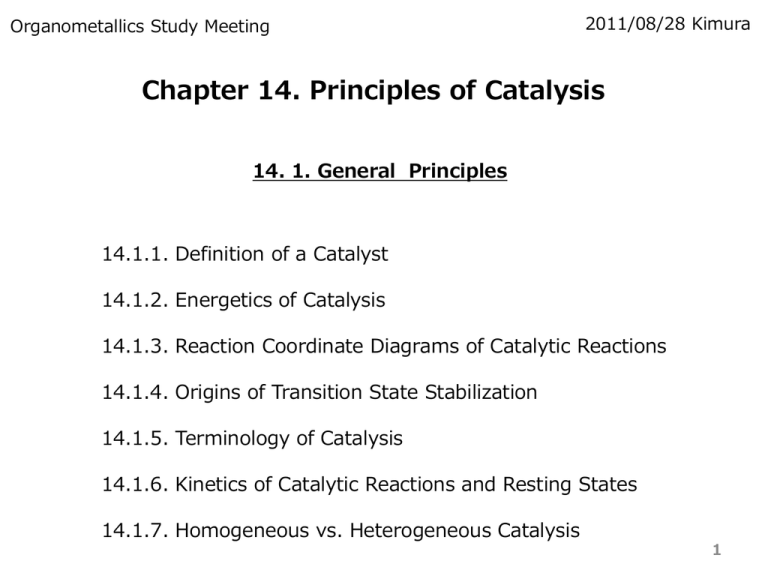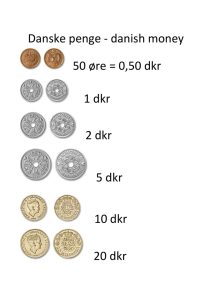**** 1
advertisement

Organometallics Study Meeting 2011/08/28 Kimura Chapter 14. Principles of Catalysis 14. 1. General Principles 14.1.1. Definition of a Catalyst 14.1.2. Energetics of Catalysis 14.1.3. Reaction Coordinate Diagrams of Catalytic Reactions 14.1.4. Origins of Transition State Stabilization 14.1.5. Terminology of Catalysis 14.1.6. Kinetics of Catalytic Reactions and Resting States 14.1.7. Homogeneous vs. Heterogeneous Catalysis 1 14. 2. Fundamentals of Asymmetric Catalysis 14.2.1. Importance of Asymmetric Catalysis 14.2.2. Classes of Asymmetric Transformations 14.2.3. Nomenclature 14.2.4. Energetics of Stereoselectivity 14.2.5. Transmission of Asymmetry 14.2.6. Alternative Asymmetric Processes: Kinetic Resolution and Desymmetrizations 2 14.2.4. Energetics of Stereoselectivity • ΔΔG‡= 1.38 kcal/mol => 10:1 ratio of product (at rt.) • ΔΔG‡= 2 kcal/mol => 90%ee 3 14.2.4.1.1 Reaction with a Single Enantioselectivity-Determining Step • simplest case: >direct reaction of catalyst. and prochiral substrate. >without coordination of subst. to cat. before enantioselectivity-determining step • atom and group-transfer reactions (epoxidation, aziridination etc.) 4 14.2.4.1.1 Reaction with Revesibility Prior to the Enantioselectivity-Determining Step: The Curtin-Hammett Principle Applied to Asymmetric Catalysis • Prochiral substrates bind to catalyst in a separate step from enantioselectivitydetermining step (EDS) •1) interconversion of I and I’ is slow relative to conversion to the product (Scheme 14.12.A) EDS = binding to the prochiral olefin faces to the metal •2) interconversion of I and I’ is significantly fast: (Scheme 14.12.B) EDS = reaction to form the product (Curtin-Hammett conditions) 5 14.2.4.1.1 The Curtin-Hammett Principle • when competing reaction pathways begin from rapidly interconverting isomers, ⇒ product ration is determined by the relative heights of the highest barriers leading to the two‡ different products (DDG ‡= GI‡- GI’ ‡) [ I ] DD G K eq exp( ) [I '] RT • DDG ‡ R S enantioselectivity is controlled by the relative energy of the two diastereomeric TSs (rather than the stabilities of the two diastereomeric intermediates) 6 14.2.4.1.3.2.1 Curtin-Hammett : Example 1: Asymmetric Hydrogenation 1 Figure 14.13. Mechanism of the asymmetric hydrogenation, illustrating a reaction meeting the Curtin-Hammett conditions 7 14.2.4.1.3.2.1 Curtin-Hammett : Example 1: Asymmetric Hydrogenation 2 8 14.2.4.1.3.2.2 Curtin-Hammett : Example 2: Asymmetric Allylic Alkylation 1 Interconversion occurs within the coordination sphere of the metal center. Figure 14.15. Interconversion of the diastereomeric p-allyls I and I’ occurs via an h1-allyl. The enantioselectivitydetermining step depends on the relative rates of psp isomerization and nucleophilic attack. • dilute conditions will help to achieve Curtin-Hammett conditions (unimolecular v.s. bimolecular) • Halide ions catalyze the isomerization • reversed enantioselectivity in the presence/absence of additives 9 14.2.4.1.3.2.2 Curtin-Hammett : Example 2: Asymmetric Allylic Alkylation 2 B. M. Trost, F. D. Toste JACS, 1999, 121, 4545 • Halide anion + diluted condition => Curtin-Hammett conditions • Ammonium cation lowers phenol nucleophilicity? 10 14.2.5.1 Effect of C2 Symmetry • it was often observed that C2-symmetric catalyst were most effective • Kagan: smaller number of metal-substrate adducts and TSs available Figure 14.15. Interconversion of the diastereomeric pallyls I and I’ occurs via an h1-allyl. The enantioselectivity-determining step depends on the relative rates of psp isomerization and nucleophilic attack. 11 14.2.5.2 Quadrant Diagrams • generic model for steric biasing of chiral metal-ligand adducts • shaded: hindered • white: less hindered • stereogenic centers close to the metal: e.g.. Pybox (Fig. 14.18.A) more distant from metal: e.g. Chiraphos (Fig. 14.18.B) • chiraphos) Me: pseudo-equatorial two phenyls: pseudo-axial (edge) + pseudo-equatorial (face) 12 14.2.6 Alternative Asymmetric Processes: Kinetic Resolutions and Desymmetrizations 14.2.6.1. Kinetic Resolutions 14.2.6.2. Dynamic Kinetic Resolution 14.2.6.3. Dynamic Kinetic Asymmetric Transformations 14.2.6.4. Asymmetric Desymmetrizations 13 14.2.6.1. Kinetic Resolutions Kinetic Resolution (KR) • reactions that occur at different rates with two enantiomers of a chiral substrate • do not usually generate additional stereochemistry • distinguish one enantiomer from another by creating new functionality • maximum yield: 50% • best option when racemate is inexpensive, no practical enantioselective route is available 14 14.2.6.1.3. Examples of Kinetic Resolutions Figure. 14.26. Kinetic resolution in the asymmetric allylic substitution Trost, B. M. et al. TL 1999, 40, 219 Schrock, R. R.. et al. JACS 1999 121 8251 15 14.2.6.2. Dynamic Kinetic Resolutions Dynamic Kinetic Resolution (DKR) • KR in a fashion that allows the conversion of both enantiomers of the reactant into a single enantiomer of the product • KR with a rapid racemization of the chiral substrate thorough an achiral intermediate (=I) or transition state •In a typical DKR: krac ≥ kfast • if substrate fully equbriuming and kfast /kslow ~ 20 => ee ~ 90% 16 14.2.6.2.1. Examples of Dynamic Kinetic Resolutions Noyori, R. et al. BCSJ 1995, 68, 36 17 14.2.6.3. Dynamic Kinetic Asymmetric Transformations (DyKAT) • Mechanism of stereochemical interconversions distinguishes DKR and DyKAT • DKR: catalyst that promotes racemization is achiral unrelated to resolution step • DyKAT: interconversion of subst. stereochemistry occurs on asymmetric cat. (epimerization) DyKAT KR DKR 18 14.2.6.3. Examples of DyKAT D. S. Glueck et al. JACS 2002 124 13556 19 14.2.6.4. Desymmetrization Reactions • differential reactivity of enantiotopic FGs of subst. with chiral reagent or cat. • catalyst differentiates between enantiotopic groups within single substrate (cf. KR: differentiate between enantiomers of a racemic substrate) Figure. 14.34. Desymmetrization of dienes by catalytic asymmetric hydrosilylation. Oxidation of the product provides a valuable 1,3-diol Ito, Y. et al. TL 1990, 31, 7333 (14.19) Shibasaki, M. et al. TL 1993, 34, 4219 20









